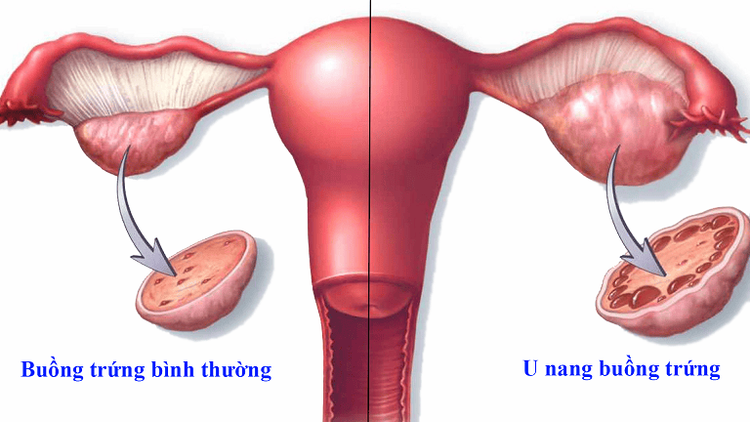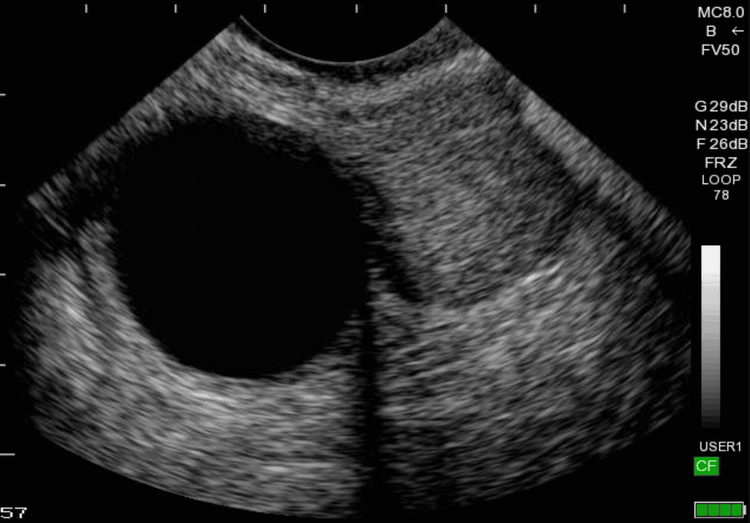This is an automatically translated article.
Articles written by doctors of Internal Oncology - Vinmec Times City International General Hospital
Ovarian cysts are included many types: ovarian cyst, pathological ovarian cyst, ovarian cancer. Each type of disease has its own causes, characteristics and treatment.
1. What is an ovarian cyst?
Ovarian cysts are fluid sacs that develop in or on the ovary. The ovaries are part of the female reproductive system. Each menstrual cycle, the ovaries release an egg, or ovum. This process is called ovulation. The ovaries also produce female sex hormones called estrogen and progesterone.
Ovarian cysts are fluid-filled sacs that can develop in or on the ovary. Cysts are usually benign, which means they are not cancerous and can go away without treatment. Ovarian cysts are relatively common in people with regular cycles because small cysts can develop spontaneously as part of the menstrual cycle.
Ovarian cysts that develop due to ovulation during the menstrual cycle are called functional ovarian cysts. Ovarian cysts are usually not cancerous and cause no symptoms. Often cysts are discovered incidentally during a routine physical exam.

Tình trạng u nang buồng trứng
Ovarian cysts are less likely to form during menstruation. Menopause marks a woman's period when she stops menstruating. However, if cysts form after menopause, they have a higher risk of becoming cancerous.
2. Pathological ovarian cysts
Occasionally, ovarian cyst cells can grow abnormally and excessively. These are called pathological ovarian cysts. Pathological ovarian cysts can sometimes be malignant, which means they have the potential to cause ovarian cancer. People who have entered menopause have a higher risk of developing pathological cysts.
Certain underlying conditions, such as endometriosis, can also cause pathological ovarian cysts. Endometriosis is a condition in which the cells lining the uterus appear outside the uterus, such as in the ovaries and fallopian tubes.

U nang buồng trứng được chẩn đoán qua siêu âm
3. Ovarian cancer
Ovarian cancer occurs when cells in the ovary grow and multiply uncontrollably to form a tumor. If left untreated, these tumor cells can spread to nearby tissues and other places in the body.
Ovarian cancer is the second most common cancer in the female reproductive organs. It usually occurs in women between the ages of 50 and 65, but can occur in younger or older women. The risk of ovarian cancer in women is about 1.4%.
Different types of ovarian cancer can develop depending on which part of the ovary the cancer begins. An epithelial ovarian tumor is the most common type of ovarian cancer and begins in the cells on the outer surface of the ovary.
4. Risk factor
Factors that increase a person's risk of developing ovarian cancer include:
● Never been pregnant;
● Early or late menopause;
● A family history of ovarian, breast, or endometrial cancer, especially if BRCA1 or BRCA2 is inherited;
● Family history of Lynch syndrome (hereditary non-polyposis colorectal cancer [HNPCC]).

Yếu tố di truyền làm tăng nguy cơ phát triển ung thư buồng trứng
5. Symptoms of Ovarian Cysts and Ovarian Cancer
People with ovarian cysts often experience few or no symptoms. The early stages of ovarian cancer may also cause no or only minor symptoms.
Or get cramps when lying down; Feeling uncomfortable in the stomach. However, if an ovarian cyst is very large, ruptures or blocks the blood supply to the ovary, it can cause symptoms similar to ovarian cancer such as:
Pelvic pain, such as pain dull or sharp pain in the lower abdomen; Abdominal discomfort, such as bloating and heaviness; Feeling full quickly after eating; Loss of appetite; Urinating often or having to go right away, quickly; Pain during sexual intercourse.

Bị đau khi quan hệ tình dục
6. Diagnosis
If ovarian cancer is suspected based on abnormal symptoms, imaging tests of the abdomen and pelvis are recommended such as: ultrasound, computed tomography (CT) or magnetic resonance imaging (MRI).
To definitively diagnose ovarian cancer requires a biopsy. A biopsy may be done during surgery. In some cases (for example, if surgery is not possible or if a woman is indicated for chemotherapy prior to surgery), a non-surgical procedure called a biopsy is performed. Can be done through peritoneal puncture or pleural puncture to check. CA125 tumor marker test (usually elevated in ovarian cancer). However, not everyone with high CA 125 levels gets ovarian cancer. Other conditions can also produce high levels of CA 125, like pelvic infections, fibroids, endometriosis, during menstruation....
To protect their own health, women should go to a gynecological examination at least once a year to actively screen and detect gynecological cancer early, avoiding negative consequences. Currently, Vinmec International General Hospital offers a basic Gynecological Examination and Screening package to help customers detect inflammatory diseases and gynecological cancers early. Customers will receive:
Gynecological specialist examination Transvaginal ultrasound of uterus and ovaries Bilateral breast ultrasound Tests such as: Treponema pallidum rapid test, Chlamydia rapid test, taking samples for cervical cytology utero-vaginal, bacterioscopic staining (female vaginal fluid), HPV genotype PCR automated system. Total urinalysis by automatic machine.
For more information, please contact Vinmec Health System Hotline or register online HERE.
Reference source: medical new today. Update 2020
MORE:
Detect and screen for endometrial cancer Do ovarian cysts require surgery? Ovarian cancer metastasis













